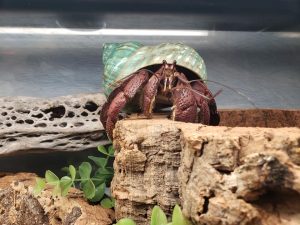Written by Stacy Griffith and originally published on All Things Crabby.com
Now that you’ve decided that a hermit crab is the pet for you, it’s time to make sure you are right for a hermit crab. If you know as much about hermit crabs as I did when I first purchased one, you are going to appreciate this information. I will cover the basics for setting up a crabitat (a cute name for your hermit crabs habitat). So BEFORE you run off to the pet store and pick out your new pets, print the shopping list at the bottom of the article and take it to the store with you. Once your crabitat is set up properly you can go and pick up your new pets. If you do this correctly from the beginning you will spend less money in the long run.
Crabitat
You need to start with a glass tank with a solid lid. The tank doesn’t need to be watertight. For this reason you can most likely find a tank for free. That’s right, FREE. So many people throw out or give away 10 gallon tanks. I have at least 5 of them I obtained for free. Sources include: craigslist, yard sales, thrift shops, flea markets and pet stores going out of business. I purchased a 20 gallon tank with a stand for ten dollars. I purchased a 40 gallon breeder tank with a lid for thirty dollars. My best find to date is a 150 gallon (that’s not a typo) tank for seventy dollars. There is no reason to buy a brand new tank. Speaking from experience, crabs are highly addictive and nearly everyone wants to own more than can comfortable live in a 10 gallon tank. If this sounds like you, go ahead and find a larger tank now.
Now for a lid. A glass lid is fine but plexiglass/acrylic works just fine also. You can measure the inner lip of your tank and then go to your local hardware store to purchase a piece of plexiglass and have it cut to fit. If your tank comes with a screen lid you can still use plexiglass for a cover and lay it on top, this allows for some venting and additional safeguard against escapes. Many crabbers will cover their screen lid with Press N Seal plastic wrap. If you have the patience to deal with this, it is acceptable. The lid needs to be secured in some fashion, a weight of some sort on top is a good idea. Hermit crabs are avid climbers. They can and WILL escape if you give them the opportunity. Hermit crabs have been seen abandoning their shell in order to execute an escape through a narrow opening. Hermit crabs can use the silicon seal to reach the top of the tank also, and they will. Don’t be surprised if your crabs cling to the underside of the screen lid.
Now we need a substrate or ground covering for the crabitat. I have tried every option currently available save calci sand. The best all around, easy to use, crab friendly substrate is play sand mixed 5:1 with coco fiber. This sand must be the child safe variety. Gravel and river rocks are not acceptable as a substrate. Coral sand is expensive but acceptable in water pools or small areas, so long as you provide another medium for burrowing and molting in the tank. Calci sand/Repti sand/Hermit crab sand is not recommended. This sand is sold in small bags and is often brightly colored. This substrate is flat out dangerous. Once it becomes damp it clumps then hardens like cement. I have seen photos of hermit crabs cemented into their shells by calci sand. Substrate should be deeper than the largest crab you intend to purchase by about 6 inches.
The tank must be kept warm so you need a heat source. Commonly, beginners start with under the tank heaters (UTH). This is acceptable but with experience and education, many crabbers will add overhead UVB lighting. Normal cycles of day and light are critical to your crab’s health and well being. Look for a UVB bulb that can be mounted inside the tank, UVB rays are greatly filtered by glass/lexan. UVB is thought to extend the lifespan of a captive hermit crab. A 5.0 reptile bulb is the norm. Heat lamps can be used alone (without at UTH) for heat and light cycle but it is challenging to maintain the correct humidity with a heat lamp. A heat bulb must be turned off at night and second night bulb must be added to maintain heat. The wattage of bulb will depend on your crabitat size and your climate. Minimum tank temperature is 75F but your tank should range from 75-82F (many species like it warmer, closer to 85F). How will you know if it’s warm enough? Well, you will need a thermometer for that. Thermometer strips are not accurate enough. A thermometer with an indicator of some sort is preferable and it should be placed midway down the side of your tank. Your tank should have a range of temperatures so it’s ok if some spots are cooler than others.
The tank must be kept humid. This is not optional, unless your goal is to kill your hermit crabs. This is accomplished by dampening the substrate, placement of water pools or moss. But you must have hygrometer to measure the relative humidity. 70-80% humidity is standard but many species enjoy higher humidity too. It’s important that you remember its RELATIVE and not actual humidity. A gauge style hygrometer can and should be calibrated before placing it in the tank, midway down the side of your tank.
So we have the house built so to speak. Let’s furnish it.
Decorations
When shopping for fun and interesting items for your crabitat there are some things to bear in mind. Hermit crabs like to climb, a lot. Hermit crabs like to dig and they like to have hidey spots during the day. Purchase items that meet these needs. Avoid anything metal, painted or chemically treated. Bear in mind that the warm, humid climate will be prime for mold and mildew. Non organic items will be resistant to mold and mildew and require less cleaning. Do not go outside and pick up random sticks and things and toss them in your tank. Not all woods are hermit crab safe and you may unwittingly introduce pests to the tank. Trees, plants, flowers are often treated with pesticides, which are lethal to hermit crabs. Fertilizers and other chemicals are not safe. If it’s not organic it shouldn’t be in the tank. Choya/Cholla is safe. Many items sold for reptiles are safe. Creative crabbers convert many household items for their crabitat, don’t be afraid to repurpose items.
The curtains are hung, the furniture is in, let’s eat!
Food and Water
Commonly, hermit crabs have been fed commercial produced food in pellet form. As interest has grown, our knowledge of the dietary needs of hermit crabs has grown tremendously. Rare is the long term crabber who feeds a straight diet of commercial food. The variety of foods that your little scavengers can consume is vast. The rules to remember are: it should be organic and free of table salt. In 2005, the myth that dairy products are deadly to hermit crabs was debunked. Prior to that, the myth that citrus fruits are deadly to hermit crabs was similarly debunked. Do not feed your hermit crabs anything with human table salt added. Not all plants are safe either. There are links at the end of this article and you can find all you ever wanted to know about hermit crab foods on these quality sites. Always feed some form of calcium. This is more important if you don’t have a UVB light.
All species of hermit crabs require constant access to fresh water AND ocean water. The dishes of water should be deep enough and large enough that your biggest hermit crab can wade into the dish and soak themselves and clean their shell. This should be considered in selecting the size of your tank, and the size of the crabs you intend to purchase. Water dishes take up space but they are non negotiable items in your crabitat. Tap water is not safe for your hermit crabs straight from the tap. This does not mean you need to buy expensive bottled water. You need a small bottle of dechlorinator drops. There are water treatment products that remove everything harmful from tap water, one drop per gallon of water. You can find these drops in the fish section of your pet store. You will need to purchase ocean salt to mix ocean water. Typically this is mixed ½ cup per gallon. I am giving you this information so you can determine how large of a package you need. I mix my water in milk jugs. 2018: Change in how to use Prime
Molting
Your hermit crabs will molt. They may even molt right after you bring them home (if you use the Post Purchase Death Reduction Method they will already be in isolation). Hermit crabs dig down in the substrate to molt. You should allow them to do so. Isolation is not required for molting. There are circumstances where you may be forced to place a molter in isolation: another crab is trying to dig up the molter OR you have a surface molter.
So instead of discovering you have a surface molter and running frantically to the store to get the needed items for a isolation tank, let’s just go ahead and get prepared for that now.
An isolation unit should be a miniature version of your crabitat, minus the decorations.
You need substrate but not deep substrate. A surface molter should be left on the surface. You should not attempt to bury the crab yourself. Same for a molter that is being harassed. So shallow substrate is fine. You need a heat source but not a light. For small crabs I like to use the small plastic kritter keepers. I place the molter into the kritter keeper, secure the lid and place the entire box right in the main tank. You will need to cover it to create a dark environment that feels safe to the hermit crab. If you choose this method, no heat source is required. Buy gauges for your isolation unit if it is to be a stand alone unit. Small kritter keepers placed in the main tank do not require gauges. Smaller food and water dishes are also needed.
Shells
Last, but not least, shells. Prepare to become an amateur shell collector. Each crab needs several empty shells to choose from. Do not buy painted shells. They are a waste of money and harmful to the crabs. Buying your shells at the pet store will be more expensive and you will not have a much of a selection. You should do some research online for the types of shells that are popular so you don’t waste your money.
And what will all of this cost me??
Let’s assume you are purchasing everything new, including a 20 gallon tank. Cost will go up with tank size of course.
BASIC SUPPLIES FOR 2 SMALL HERMIT CRABS (2015 prices)
- 20 Gallon Aquarium $ 25.00
- 2 bags of play sand $7.00
- 2 med reptile water dishes $15.00
- 1 med reptile food dish $ 8.00
- 1 pkg of 2 forest moss bricks $10.00
- 1 Glass aquarium lid $20.00
- 16 Watt UTH $40.00
- 1 Box Instant Ocean $8.00
- 1 Bottle Prime water conditioner $5.00
Approximately $140.00 and that’s without any hermit crabs, a light or spare shells. So much for hermit crabs being a cheap, easy, throw away pet. This may seem like a lot of information but honestly, it’s just the tip of the iceberg.
Additional Reading
Refining the purpose of isolation



